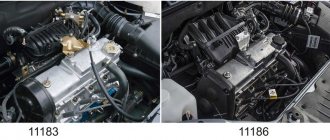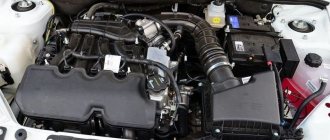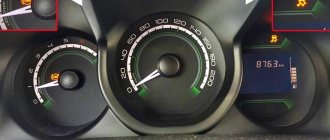For an increase of 3 hp. and 3 Nm, a large-scale modernization is hidden in the VAZ-11182 engine.
Lada Granta with a new engine: how does it drive? what resource?About modern VAZ engines
The manufacturer offers a choice of two 8 valve engines :
- VAZ-11183-50 (82 hp) is a modified VAZ-2111 engine, as a result of which environmental performance has increased, the engine has become more reliable and less capricious. It also has the advantage of elasticity and traction. Disadvantages include periodic valve adjustments and noisy engine operation. If the timing belt breaks, the valve does not bend.
- VAZ-11186 (87 hp) is a modified VAZ-21114 engine, as a result of which it was possible to reduce noise and gasoline consumption. Environmental friendliness has improved and power has increased noticeably. Disadvantages: compared to the VAZ-11183, this engine has a shorter service life. When the timing belt breaks, the valves bend.
16 valve engines :
- VAZ-21126 (98 hp) is a continuation of the VAZ-21124 engine and is currently one of the most advanced domestic engines. Disadvantage: valve bends when the timing belt breaks.
- VAZ-21127 (106 hp) is a modified VAZ-21126 engine. In comparison, the engine has become more torquey at the bottom, the changes are minor, but noticeable. The disadvantages include bending of the valves when the timing belt breaks.
What is engine life
Each machine has a device that determines its movement. This power unit is called an engine. In turn, each motor has a certain operating life, during which no intervention in its design is required. In mechanics, this concept has a precise name - engine life.
In other words, the resource is the mileage before the onset of repair work related to the dismantling of the crankshaft of the unit. The limiting state is determined by a drop in engine power, the appearance of uncharacteristic noise during its operation (knocking, creaking, etc.) or an increase in oil and fuel consumption.
In most cases, the condition of the engine is not related to mileage. The main factors influencing the reliability of its operation are operating conditions and workmanship. An engine operated in compliance with the rules can travel hundreds of thousands of kilometers without repair.
The engines installed on the Lada Grant belong to a new generation of power units that are successfully used by domestic models. These are engines 11183 in the standard configuration, 11186/21116 in the standard configuration, and 21116 in the luxury configuration. Each of them has its own characteristics and characteristics, which need to be considered in more detail.
Maintenance
Guaranteed operation of the VAZ-11186 engine is ensured by following the manufacturer’s recommendations:
- operating modes;
- timing of maintenance.
Maintenance of the VAZ-11186 engine comes down to:
- Regular inspection of the power unit, as a result of which oil and coolant leaks can be detected. If such defects are identified, they must be eliminated;
- Regular replacement of engine oil - every 15,000 km. It is recommended to use motor oil from well-known manufacturers, purchasing it from trusted suppliers.
VAZ 11183/21114
The volume of the power plant is 1.6 liters. In fact, it is a development of the old one and a half liter engine. Engineers managed to increase reliability by replacing the materials used to produce some elements and optimizing the design. If we talk about the resource, the manufacturing plant itself set the mark at 150 thousand kilometers. Practice shows that
values of 250-300 thousand are quite achievable if certain recommendations are followed. The main requirement is timely oil changes, effective heat removal will reduce wear on all engine elements. A big plus of the engine is its resistance to timing belt breaks; even in a critical situation, the likelihood of valve bending is minimal.
Engine Features
Due to the design of the car's cooling system, the engine does not warm up above 80 degrees. The management of AvtoVAZ does not see anything wrong with this; they have an official information letter on this matter. You can read it in the material: What is the operating temperature of an 8 valve engine.
The engine design is as simple as an axe. There are no hydraulic compensators, no sores were noticed. Mostly problems can arise due to malfunctions in the engine management system.
Video of acceleration to 100 km per hour
I haven’t shot my video yet, it’s winter, so we’ll wait for the weather to warm up. That's when I'll post it on our YouTube channel. In the meantime, here's a video from Grantovodov.
Here's another interesting video. It is interesting because the measurement is made using an application with a navigator , which means that the speedometer readings are more accurate if the navigator is well calibrated. Everyone knows that the higher the speed, the more the car’s speedometer lies.
New 8-valve VAZ-11182
In 2022, AvtoVAZ introduced a new engine for the Lada Granta FL. This is AR16SEg2 or VAZ-11182. Its main feature is an increase in torque. At 1000 rpm, 80% of the torque is already available.
Design changes include:
- renewal of the connecting rod and piston group;
- modernization of the gas distribution mechanism;
- crankshaft modernization.
Advantages of VAZ-11182:
- reduced consumption;
- reduction in switching frequency;
- no need to adjust valves up to 90,000 km;
- groove;
- absence of oil drips due to six-bolt fastening of the oil cap and improved design of the silicone gasket;
- use of Renault spare parts;
- resource 180,000 km.
Disadvantages of the VAZ-11182:
- lack of hydraulic compensators;
- complicated valve clearance adjustment (at a mileage of 90,000 km);
- increased compression ratio, for better torque you will need to fill in AI-95;
- high cost of spare parts.
H
H
It not only frees you from unnecessary operations, but also ensures correct tension, which affects the service life no less than the quality of the belt itself. If you overtighten, the roller and water pump bearings will suffer. The latter, by the way, has also been modernized: a more reliable bearing and oil seal have been installed, and the performance has also been increased (the unit is from a sixteen-valve engine, only with a pulley for a narrow belt).
Description
The Grant engine is a modernized version of the long-produced engines 21124 and 11183. It differs from its predecessors by the presence of a 39% lighter connecting rod and piston group developed by Federal Mogul. For the VAZ-11186 engine it is manufactured directly at AvtoVAZ OJSC.
As a result of the modernization, significantly:
- power increased;
- exhaust toxicity has decreased;
- fuel consumption has decreased.
The cylinder head has become much stronger, since during manufacturing it undergoes a special heat treatment cycle. In addition, it is further strengthened by metal gaskets.
Despite the fact that all the motors in the line are assembled according to an identical design, the 11186 engine has a number of design features. Among them are:
- Improved cooling system for the block and cylinder head. The piston group is covered with a cooling jacket along its entire height and is equipped with piston cooling nozzles, which prevents deformation of the cylinder block due to uneven heating.
- Using a new camshaft drive design equipped with an automatic tensioner.
- The original design of the crankshaft, equipped with special oil channels, which are closed with plugs. This required the use of high-strength cast iron for its manufacture.
A significant drawback of the grant engine is that if the timing belt breaks, the valves bend, which can lead to failure of the power unit as a whole (breakage of pistons and cylinders). In order to protect the engine, a highly reliable drive belt is installed at the manufacturing plant during assembly, which is manufactured by the American company Gates Rubbler Company. The service life of this belt is at least 200 thousand kilometers.
Interesting: As a result of modernizing the VAZ-11186 engine, it became possible to equip it with an electric throttle valve drive (E-gas). This allows you to increase its power to 90 hp. With.
Engine on Grant: features
So, the Grant 21116 1.6-liter 8-valve gasoline engine is a modernized 1.6-liter VAZ 2114 engine. The idea to modernize the VAZ 2114 engine arose in connection with the release of the Grant car and the transition of the entire model range to Euro-4.
Initially, ICE 21116 was installed on the Lada Priora and then on the Lada Granta and Lada Kalina cars. List of main technical characteristics:
- injection power system;
- in-line 4-cylinder engine with a power of 87 hp;
- engine capacity 1596 cm3;
- the presence of two valves per cylinder;
- the maximum torque is 140 Nm;
- the presence of an intake manifold with extended channels and a flange for an electronic damper (increased torque);
- new H-module.
The 87 hp Grant engine, especially in comparison with its predecessor VAZ 21114, has a lightweight connecting rod and piston group. This feature of the 21116 engine has its advantages and disadvantages.
By lightening the parts and elements of the internal combustion engine, the service life of the valve-piston group decreases, but at the same time the dynamics and other indicators improve. For example, an increase in power to 87 hp, which is 6 hp. more than that of ICE 21114.
Main characteristics of the Lada Grand car with a VAZ 21116 engine installed on it:
- The maximum speed of the car is 167 km/h;
- Fuel consumption 8.5 l. per 100 km (when driving in the urban cycle);
- Fuel consumption 5.7 l. per 100 km (when driving on the highway);
Let's move on. If we consider the Granta 8-valve engine and its design, the Granta 8-valve engine has several design features that distinguish it from other modifications.
Firstly, the plate honing method is used to finalize the surfaces of the cylinders. Secondly, the presence of oil nozzles allows for more intensive lubrication and cooling of the pistons.
The dimensions of the internal combustion engine parts have also been reduced: the height of the cylinder block is about 197.1 mm; the crank radius is about 37.8 mm; piston ring height 1.2/1.5/2 mm, etc.
Another thing worth noting is the electromechanical throttle module installed at the receiver input. This design solution allows the ECU to fully control both the fuel supply and the air supply to the cylinders.
Let us add that the main design feature of the Grant 21116 internal combustion engine was the lightweight ShPG connecting rod and piston group. In the previous model, exhaust gas flows collided and created back pressure.
For this reason, in the case of the VAZ 21116, the designers decided to lengthen the collector pipes by changing the shape of the cylindrical block and the inlet pattern. As a result, such actions helped reduce losses and resistance.
Alternative engines
VAZ-21904
VAZ-21904 is a gasoline-powered sixteen-valve turbo engine with a displacement of 1.4 and a power of 163 hp. In addition, it is equipped with a lithium-ion battery and an electric motor. The basis for it was the VAZ-11194 engine; it was installed on Lada Kalina cars in the first generation. As for the VAZ-21904 itself, it is installed on Grant hybrids - VAZ-21904 sedans. The Volzhsky Automobile Plant tested four such vehicles equipped with three different hybrid engine options.
Fifth gear was replaced by the shaft of a robotic gearbox; it rotates thanks to a small electric motor with a power of 11 kW. This option turned out to be simpler and cheaper than using the standard scheme with the electric motor located between the gearbox and the internal combustion engine. Thus, there are four gears left, but this aspect will not create any problems for the car owner - the maximum speed (160 km/h) is achieved by the car in fourth gear.
Also, the terms of reference required the developers to fulfill two mandatory conditions - charging a hybrid car from electrical networks used in everyday life and the ability to move it in two modes at once - combined and electric. AvtoVAZ’s partners in the development of electronics were the Russian research institute NAMI and the Ricardo company from the UK. It was NAMI that developed the battery and electric motor for a hybrid car.
The car is capable of starting to move purely on electric power, with the internal combustion engine switched off. During the process of gaining speed, the gear shift will be carried out by a “robot”, and the precise output of the electric motor is responsible for synchronizing the rotation of the gears at this moment. When you start the gasoline engine, the car will begin to work in hybrid mode - with the same gear shifting, in which the electric motor will either help rotate the input shaft of the box, or will switch to generator mode, charging the battery.
According to tests, a hybrid car will consume 21% less fuel than a Granta with a conventional 1.6 engine. (measurements, of course, were carried out in a gentle mode, but the result obtained is very good).
Of course, only a few hope that the hybrid Lada Granta will be in great demand and will be able to generate any significant interest in the car market in the near future. At the moment, such vehicles are nothing more than a kind of aggregate carriers intended for testing various components separately. If we talk specifically about the hybrid type transmission, its serial production will begin in at least two to three years, and it will be installed on quite expensive Lada cars, most likely C-class. Thus, it is quite possible over time and we should expect an increase in demand for hybrid cars, but the main condition for this is a fundamental change in the attitude towards “ecological” transport not only of motorists, but also of the state, as well as the vehicle manufacturers themselves.











